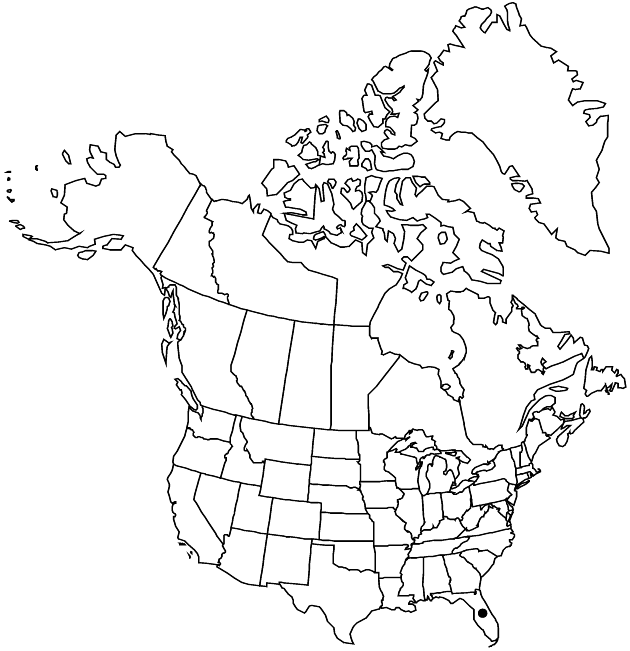Difference between revisions of "Liatris ohlingerae"
Contr. Gray Herb. 104: 49. 1934.
FNA>Volume Importer |
imported>Volume Importer |
||
| (3 intermediate revisions by 2 users not shown) | |||
| Line 8: | Line 8: | ||
}} | }} | ||
|common_names=Florida gayfeather;sandtorch | |common_names=Florida gayfeather;sandtorch | ||
| + | |special_status={{Treatment/ID/Special_status | ||
| + | |code=E | ||
| + | |label=Endemic | ||
| + | }} | ||
|basionyms={{Treatment/ID/Basionym | |basionyms={{Treatment/ID/Basionym | ||
|name=Lacinaria ohlingerae | |name=Lacinaria ohlingerae | ||
|authority=S. F. Blake | |authority=S. F. Blake | ||
| + | |rank=species | ||
|publication_title=Bull. Torrey Bot. Club | |publication_title=Bull. Torrey Bot. Club | ||
|publication_place=50: 203, plate 9. 1923 | |publication_place=50: 203, plate 9. 1923 | ||
| Line 17: | Line 22: | ||
|name=Ammopursus ohlingerae | |name=Ammopursus ohlingerae | ||
|authority=(S. F. Blake) Small | |authority=(S. F. Blake) Small | ||
| + | |rank=species | ||
}} | }} | ||
|hierarchy=Asteraceae;Asteraceae tribe Eupatorieae;Liatris;Liatris ohlingerae | |hierarchy=Asteraceae;Asteraceae tribe Eupatorieae;Liatris;Liatris ohlingerae | ||
| Line 41: | Line 47: | ||
-->{{#Taxon: | -->{{#Taxon: | ||
name=Liatris ohlingerae | name=Liatris ohlingerae | ||
| − | |||
|authority=(S. F. Blake) B. L. Robinson | |authority=(S. F. Blake) B. L. Robinson | ||
|rank=species | |rank=species | ||
| Line 55: | Line 60: | ||
|publication title=Contr. Gray Herb. | |publication title=Contr. Gray Herb. | ||
|publication year=1934 | |publication year=1934 | ||
| − | |special status= | + | |special status=Endemic |
| − | |source xml=https:// | + | |source xml=https://bitbucket.org/aafc-mbb/fna-data-curation/src/2e0870ddd59836b60bcf96646a41e87ea5a5943a/coarse_grained_fna_xml/V19-20-21/V21_1348.xml |
|tribe=Asteraceae tribe Eupatorieae | |tribe=Asteraceae tribe Eupatorieae | ||
|genus=Liatris | |genus=Liatris | ||
Latest revision as of 21:09, 5 November 2020
Plants 30–100 cm. Corms nearly cylindric. Stems minutely and closely villous-puberulent, glabrescent. Leaves: basal and proximal cauline (usually withering before anthesis) 1-nerved, linear, 80–150 × 1–2(–2.5) mm, gradually reduced distally, essentially glabrous or sparsely puberulent and soon glabrescent, gland-dotted. Heads (1–30) in open, corymbiform to racemiform arrays. Peduncles (spreading-ascending) 20–70 mm. Involucres hemispheric to campanulate or broadly turbinate, 17–23 × 15–20 mm. Phyllaries in 6–7 series, oblong, strongly unequal, essentially glabrous, margins with (faintly purplish) hyaline borders, ciliolate, apices rounded to obtuse. Florets ± 20–30; corolla tubes glabrous inside. Cypselae 7–10 mm; pappi: lengths ± equaling corollas, bristles barbellate to subplumose.
Phenology: Flowering (Jul–)Aug–Nov.
Habitat: Oak scrubs, scrubby flatwoods, rosemary scrub
Elevation: 10–50 m
Discussion
Liatris ohlingerae grows in DeSoto, Highlands, and Polk counties, on Lake Wales Ridge. It is in the Center for Plant Conservation’s National Collection of Endangered Plants.
Selected References
None.
